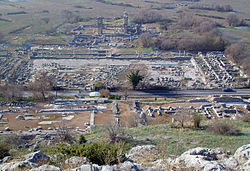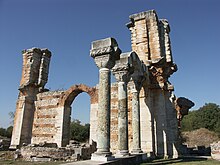Philippi
| Philippi | |
|---|---|
|
UNESCO world heritage |
|

|
|
| City center |
|
| National territory: |
|
| Type: | Culture |
| Criteria : | iii, vi |
| Reference No .: | 1517 |
| UNESCO region : | Europe and North America |
| History of enrollment | |
| Enrollment: | 2016 ( session 40 ) |
Philippi ( ancient Greek Φίλιπποι ) was an ancient city and fortress in the east of Macedonia , near the Thracian border in the plain traversed by the Angites . It is located about 15 km northwest of today's Kavala near the village of Krinides in Greece . In July 2016, the archaeological site of Philippi was declared a UNESCO World Heritage Site because of its importance as a Roman city and the oldest Christian church plant in Europe .
history
Thracian and Macedonian rule
The city, first inhabited by the Thracian peoples, was the center of the plain between the Strymon and Nestos rivers . The plain was bordered by several mountains (Orbelos, Pangaion , Symvolon) and was most easily accessible from the west. Thracian cults can be proven through many inscriptions and rock reliefs. Philippi originally had the Thracian place name Daton . The branch existed since 362 BC. BC as the foundation of the Thasites within their Peraia under the name Krenides . The name was changed to Philippi by Philip II of Macedonia , who lived around 355 BC. In the course of the expansion of the Macedonian sphere of influence to the east. The coins of the Macedonian king are evidence of this change of rule and name. Despite the mining of rich precious metal deposits from the nearby Pangaion Mountains, agriculture dominated in Philippi. In the era of Hellenism , the city was autonomous.
Part of the Roman Republic
168 BC BC Lucius Aemilius Paullus Macedonicus conquered Macedonia. First it was declared free by the Romans and divided into four independent parts ( merides ), with Philippi coming to the first merís . 148 BC Macedonia became a Roman province . Philippi gained importance because of its location on the Via Egnatia , which the Romans used between 146 and 120 BC. BC across Thrace and Macedonia to the Adriatic Sea as the main traffic axis between Rome and the Middle East. From Philippi there was a junction to the north, which led over the Rhodope Mountains to Philippoupolis and the Via Militaris .
In October / November 42 BC The double battle at Philippi took place west of the city between the Caesar murderers Marcus Junius Brutus and Gaius Cassius Longinus on the one hand and the triumvirs Mark Antony and Octavian on the other. Brutus and Cassius were beaten and committed suicide.
After the battle, Mark Antony founded a Roman colony in Philippi and settled veterans who supplemented the previous inhabitants. After Octavian's victory over Antony and his suicide (30 BC), the colony was expanded by other Italians who had settled there and 27 BC. The new name Colonia Augusta Iulia Philippensis . From this date until the 3rd century the Roman way of life and culture dominated in Philippi, so that Collart speaks of a Rome in miniature format (Rome en miniature) . Agriculture continued to dominate the economic sector.
The tombstone of Tiberius Claudius Maximus was found near Philippi in 1965.
The apostle Paul in Philippi
Around 49/50 AD, the apostle Paul and Silas founded a Christian community in Philippi ( Acts of the Apostles (16.11-40 EU )). It is the first church that he planted in Europe. The first Christian to be named is the purple merchant Lydia , who came from Thyatira in Asia Minor. As a non-Jewish "God-fearing" person, she had already adhered to the Jewish community beforehand. Paul had gone to a Jewish place of worship by the river and spoken to the women who had gathered there. Lydia and everyone in her home were baptized based on the apostle Paul's preaching. Paul probably wrote the letter to the Philippians to the church in Philippi from Rome, where he was living in captivity, around 60 .
Roman Imperial Era and Middle Ages
From the 4th to the 7th centuries, several Christian bishops from Philippi were attending councils. In 473 the Ostrogoths under Theodoric Philippi besieged in vain. The Bulgarians took the city in 837. In the 10th century it belonged again to the Byzantine Empire. With its final conquest by the Ottoman Empire in the late 14th century, Philippi disappears from the sources.
ruins
The impressive Roman ruins of Philippi are close to the modern city of Kavala . Among other things, there is a well-preserved wall ring and an acropolis , as well as a large forum on the plain with a few houses, a gymnasium and a market hall.
The ancient theater is also an important and remarkable monument. It is located at the foot of the Acropolis and is bounded to the east by the old city wall. Although there have been numerous changes and some interventions for the implementation of the Philippi Festival over the centuries, many original elements have been preserved.
saying
The saying “We'll see each other again at Philippi” goes back to the ancient biographies that Plutarch wrote about Caesar and Brutus. There it is reported (Caesar 69; Brutus 36) that a ghost appeared to Brutus who told him: "We'll see each other at Philippi!" William Shakespeare's Roman drama Julius Caesar takes up this. Today the saying describes an event that is certain to occur (in the sense of “we will definitely see each other again”) or the opportunity to take revenge.
sons and daughters of the town
- Eustathios of Antioch , who died here in exile in 337
literature
- William Barclay : Acts of the Apostles (New Testament Interpretation series). Neukirchen-Vluyn 1991
- Paul Collart : Philippes Ville de Macédoine, depuis ses origines jusqu'à la fin de l'époque romaine. Paris 1937.
- Paul Collart: Art. Philippes . DACL 14 (1939) pp. 712-41.
- Peter Pilhofer : Philippi . Vol. I: The first Christian community in Europe. WUNT 87, Tuebingen 1995
- Peter Pilhofer: Philippi . Vol. II: Catalog of the inscriptions by Philippi, 2nd, revised. u. erg. A., WUNT I 119, Tübingen 2009.
Web links
- Entry on the UNESCO World Heritage Center website ( English and French ).
- The inscriptions of the city of Philippi can be viewed at www.philippoi.de .
- Jona Lendering: Philippi . In: Livius.org (English)
Individual evidence
- ↑ Greece's Philippi Inscribed on UNESCO's World Heritage List . news.gtp.gr of July 15, 2017, accessed on August 22, 2017.
- ↑ Udo Schnelle: Introduction to the New Testament. 8th edition, Vandenhoeck & Ruprecht, Göttingen 2013, ISBN 978-3-8252-3737-0 , p. 163.
- ↑ Ancient Theater of Philippi: Public Benefit Organization Of Kavala. Retrieved November 29, 2017 .
Coordinates: 41 ° 0 '43.3 " N , 24 ° 17' 4.9" E



